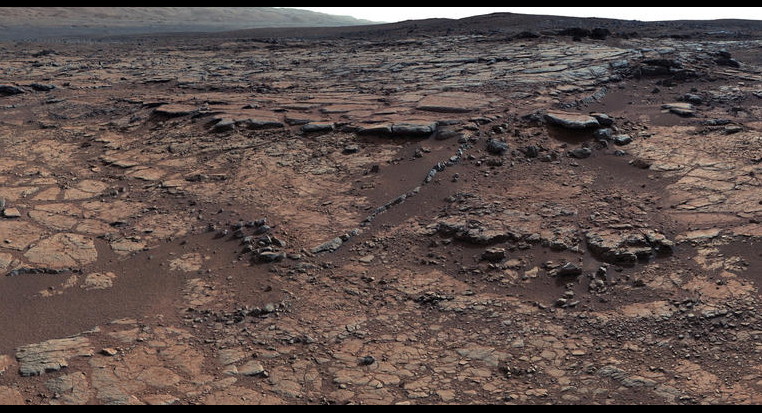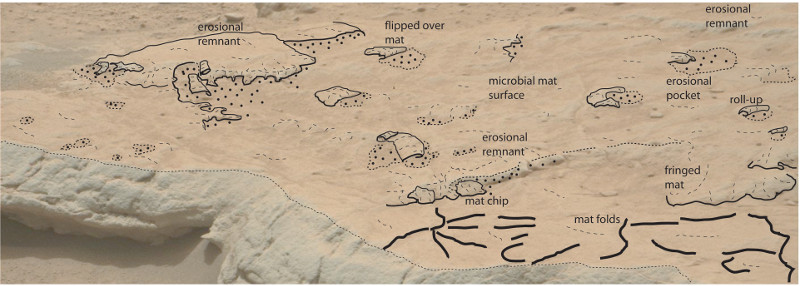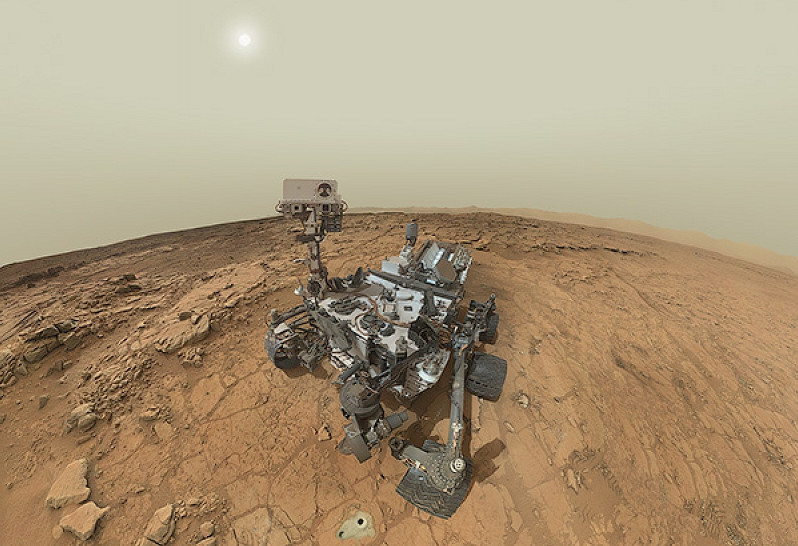Mars Fossils? Curiosity Rover Team Questions Report on Potential Microbe Traces

Scientists on the Curiosity team have brought into question a recent report about potential trace fossils in the NASA Mars rover's images of the Gillespie rock outcrop. Astrobiology Magazine reached out to the team and to the study's author for further comments.
In a paper published last month in the journal Astrobiology, geobiologist Nora Noffke drew attention to features in Martian rocks that she suggested bore striking resemblance to trace fossils of microbial mats on Earth. (For more details, read Astrobiology Magazine's original story here.)
Not everyone agreed with her interpretation. As Curiosity's project scientist Ashwin Vasavada explained to other news outlets (including Space.com), the team had evaluated the features as non-biological, likely having been shaped by erosion or the transport of sand in water. Vasavada had also raised questions about the decision to publish the report. [The Search for Life on Mars: A Photo Timeline]
Astrobiology Magazine reached out to members of the Curiosity team for clarification, to Dr. Noffke for further comments, as well as to the managing editor of the journal Astrobiology for insight into the review process.
Hypothesis-driven science
"I'm intrigued by the topic, and skeptical about the interpretation," said Jack Farmer, a geobiologist at Arizona State University and member of the Curiosity team. "But she does provide a valuable set of observations, and a hypothesis that is potentially testable in the future."
"We want hypothesis-driven science, but we should always be striving to disprove our own hypotheses," he added. "Science has been described as the orderly accumulation of rejected hypotheses. We need multiple and integrated lines of evidence to show that the features are not easily explained by non-biological processes."
Linda Kah, a geobiologist the University of Tennessee and a co-investigator on the Curiosity rover team, said the team carefully investigates all outcrops, and that in the Gillespie outcrop they did not see anything that could not have been explained via abiotic processes.
Breaking space news, the latest updates on rocket launches, skywatching events and more!
"There cannot simply be the assumption of biogenicity," Kah said. "In science, the null hypothesis (that these are abiotic) must be disproved in order to accept biogenicity." [Mars Myths & Misconceptions: Quiz]
However, Noffke argues that her report does take into account non-biological explanations. "The third part of my article describes potential abiotic modes of formations for these structures, and also explains why they point towards a possible biological origin," she said.
She also notes that the distribution patterns of microbial structures on Earth vary depending on where they are found, and also change in a specific way over time. She argued that the distribution patterns of the Martian structures are consistent with those for microbial structures on Earth.
"Again, I do not claim to have found fossil life on Mars," she said. "My paper is carefully framed as a founded hypothesis, and I only go as far as the data allows me to."
A rock bed on the Gillespie Lake outcrop of the Yellowknife Bay formation.
Trace fossils or erosion?
"Noffke did a substantial amount of work and analysis, but it is based on a flawed underlying assumption," Dawn Sumner, a geobiologist at the University of California, Davis and a Curiosity team member, wrote in an email. "The surfaces described in the paper are very strongly shaped by recent erosion and thus do not preserve original structures."
Noffke responded to that argument by noting that erosion typically follows the biological structures embedded in rocks. "Erosion is strong where there is little resistance in the rock, and weak where there is a lot of resistance," she said.
Noffke added: "With a sedimentary surface composed of harder material, erosion will exhume these harder portions by removing the softer parts around it first. This is how dinosaurs and other fossils often resurface after being buried for millions of years."
Still, Sumner, who also studies modern and ancient microbial mat communities on Earth, does not agree with the interpretation.
"I would argue that the textures on the surfaces of the rocks are weathering-like, not MISS-like [microbially induced sedimentary structures], but I haven't made diagrams to show that," Sumner said. "I simply don't see anything that can't be explained by differential weathering, which we know happens on Mars."
Preserved in sandstone?
Another objection, raised by Vasavada, dealt with the formation of microbial sedimentary structures under water current.
"Given that the Gillespie formation was sandstone, it probably formed in a more active stream environment, which would not be the most conducive for preserving organics," Vasavada told the LA Times.
But Noffke rebuts this argument, saying that a 2014 study by Jack Farmer and colleagues described microbial sedimentary structures preserved in such environments on Earth.
"Her report can't be dismissed casually; it draws attention to things we should look for in the future," Farmer said. "Her hypothesis is something to carry forward and test objectively."
He added: "In the case of our 2014 study, we applied multiple lines of evidence, including microfossils and sedimentological observations, to support our claims."
As NASA planetary scientist Chris McKay had commented in our earlier article, a Mars sample-return mission would be the best way to resolve the case. But unfortunately this is just not technologically feasible yet.
Publishing a hypothesis
Members of the Curiosity team had also raised questions about the decision to publish the article.
"We were surprised that such a bold claim was out there in the scientific literature," Vasavada told the LA Times. "It's interesting… It's just that we don't think the evidence is quite as strong as what is described in the paper."
Astrobiology Magazine reached out to the journal Astrobiology (a scientific publication not affiliated with the magazine) for further insight into the review process.
Its editor-in-chief, Sherry Cady, is a biogeochemist and an expert on microbe-sediment interaction. She also serves as chief scientist at the Pacific Northwest National Laboratory, a research facility in Richland, Washington that's funded by the U.S. Department of Energy.
She commented: "The peer-review process was in-depth and held to the highest standards. The original manuscript was sent out to five referees, experts in the field and all seasoned referees. The paper went through four formal revisions with four of those referees until all of their concerns were met. The paper was then edited and reviewed again by myself and Senior Editor Norm Sleep."
"Noffke's paper proposes a testable hypothesis, based on three lines of evidence, as a rover on Marscan carefully image and chemically sample putative MISS-like features," Cady added. "Experts in the field who wish to clarify matters of scientific content in papers published in Astrobiology are encouraged to submit their comments for publication in the journal."
"In this way, mission scientists and scientific experts around the world, whose research aligns with planetary exploration goals and objectives, can together strengthen the community's efforts to contribute in meaningful ways to ongoing planetary and space science."
Follow Johnny Bontemps on Twitter. This story was provided by Astrobiology Magazine, a web-based publication sponsored by the NASA astrobiology program. Follow us @Spacedotcom, Facebook and Google+.
Currently a freelance writer based in Western Massachusetts, Johnny is a former contributor to Space.com in the fields of science, astronomy, comets, mars rovers, and the search for life. His articles have appeared in Narratively, Nautilus, and NASA Astrobiology magazine. From 2014 to 2019, he was a writer and producer at Startalk Radio, the Emmy-nominated and Webby Award-winning talkshow hosted by the celebrity astrophysicist Neil deGrasse Tyson.




